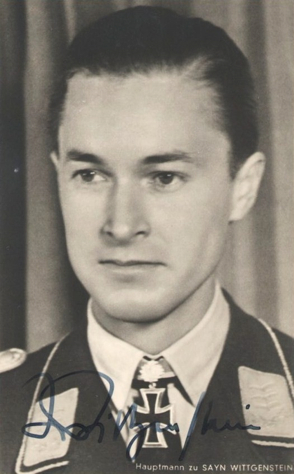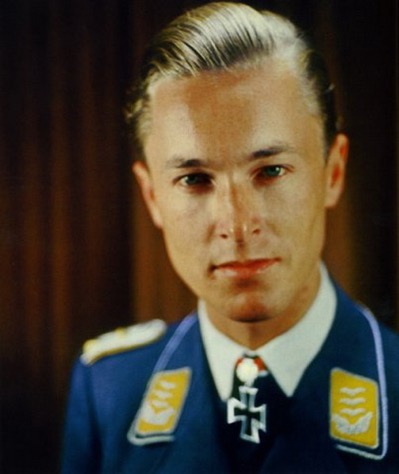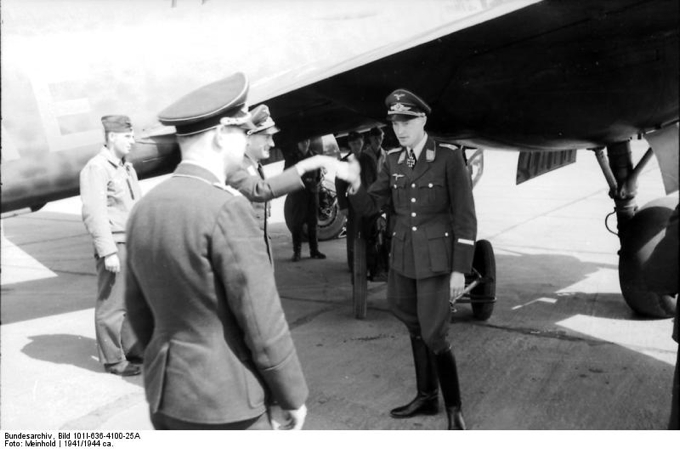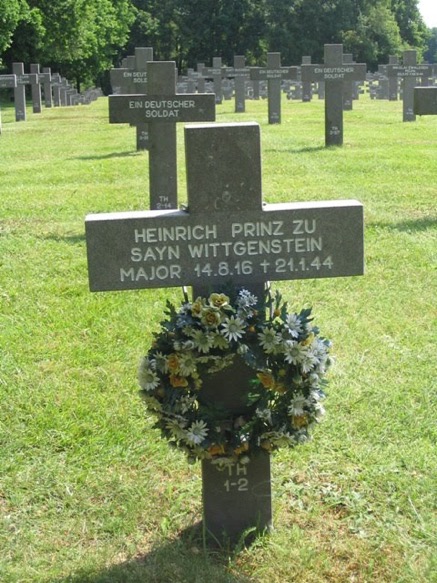Date: 21st January 1944
Unit: Stab./Nachtjagdgeschwader 2
Type: Junkers Ju 88C-6
Werke/Nr.750467
Coded: R4 + XM
Location: Lübars-Schöhauser-Damm near Stendal, Germany.
Pilot: Major. Heinrich Prinz zu Sayn-Wittgenstein. 53547/97 - Killed. Born 14.08.1916 in Copenhagen.
Radio/Op: Feldwebel. Friedrich Ostheimer. - Baled out.
Gunner: Unteroffizier. Kurt Matzuleit. 60780 a/7 - Baled out. Born 28.11.1922 in Neidenburg.
REASON FOR LOSS:
On the night of 20 January 1944 Sayn-Wittgenstein claimed three enemy aircraft shot down in the Berlin area (victories 76–78). He almost collided with the third burning Lancaster which went into a dive and came very close to his own Ju 88. The Ju 88 went out of control and Sayn-Wittgenstein regained control of his just flyable aircraft. His radio operator on this mission, Feldwebel Friedrich Ostheimer established contact with airfield at Erfurt. Since the aircraft began stalling after the wheels and flaps went down the crew decided to belly-land the aircraft. They discovered that about 2 meters (6.6 ft) of the wing had been cut off by the Lancaster's propeller.
The next day, 21 January 1944, Sayn-Wittgenstein, wireless operator Ostheimer and board mechanic Unteroffizier Kurt Matzuleit took off on a Zahme Sau (Tame Boar), a combination of ground controlled and airborne radar, night fighter intercept mission flying the Ju 88 R4+XM, which normally was assigned to the Technical Officer of NJG 2. At 22:00 contact with the first of five Lancasters was established and shot down which was observed to explode at 22:05. Between 22:10 and 22:15 the second Lancaser was shot down. Observers reported the third Lancaster exploded at approximately 22:30, followed shortly by number four, which hit the ground at 22:40. During the fifth and final attack, the four engined bomber was burning when their Ju 88 came under attack, presumably from British fighter escorts. In the attack, their left wing caught fire. Sayn-Wittgenstein ordered his crew to jump and Ostheimer and Matzuleit parachuted to safety from the damaged aircraft. Sayn-Wittgenstein's body was found near the wreckage of the Ju 88 in a forest area belonging to the municipality of Lübars by Stendal the next day. His parachute was discovered unopened and it was assumed that he may have hit his head on the vertical stabiliser of his aircraft when trying to escape. The death certificate listed "closed fracture of the skull and facial bone" as his cause of death. He was posthumously awarded the 44th Knight's Cross of the Iron Cross with Oak Leaves and Swords (Ritterkreuz des Eisernen Kreuzes mit Eichenlaub und Schwertern) on 23 January 1944. Heinrich Prinz zu Sayn-Wittgenstein had flown 320 combat missions, 150 of which as a bomber pilot or observer. At the time of his death he was the leading night fighter pilot with 83 aerial victories, with 23 of them claimed on the Eastern and 60 on the Western Front.
On 25 January 1944, Heinrich zu Sayn-Wittgenstein death was announced in the Wehrmachtbericht, an information bulletin issued by the headquarters of the Wehrmacht, the name of the unified armed forces of Germany from 1935 to 1945.
Der Kommodore eines Nachtjagdgeschwaders Major Prinz zu Sayn-Wittgenstein fand im nächtlichen Kampf gegen feindliche Terrorflieger bei seinem 83. Nachtjagdsieg nach Vernichtung von fünf britischen Bombern den Heldentod. Der Führer ehrte den gefallen Nachtjäger durch Verleihung des Eichenlaubs mit Schwertern zum Ritterkreuz des Eisernen Kreuzes. Mit ihm verliert die deutsche Luftwaffe einen ihrer hervorragendsten Nachtjagdflieger
The commodore of a night fighter wing Major Prince zu Sayn-Wittgenstein found, engaged in combat with enemy terror fliers, after achieving his 83rd nocturnal aerial victory, after destruction of five British bombers, a heroes death. The Führer honored the fallen night fighter with the presentation of the Oak Leaves with Swords to the Knight's Cross of the Iron Cross. With him the Luftwaffe loses one of their most outstanding night fighter pilots.
Wound Badge in Black Front Flying Clasp of the Luftwaffe for Bomber Pilots in Gold
Front Flying Clasp of the Luftwaffe for Night Fighter Pilots in Gold
Ehrenpokal der Luftwaffe (15 September 1941)
Combined Pilots-Observation Badge
German Cross in Gold on 21 August 1942 as Oberleutnant in the 6./NJG 2
Iron Cross (1939) 2nd and 1st class
Knight's Cross on 2 October 1942 as Hauptmann and Staffelkapitän of the 9./NJG 2 290th Oak Leaves on 31 August 1943 and Hauptmann and Gruppenkommandeur of the I./NJG 100
44th Swords on 23 January 1944 (posthumously) as Major and Geschwaderkommodore of NJG 2
Source: Wikipedia 2011
 cc
cc 
Prinz zu Sayn-Wittgenstein


Final resting place
He was buried on 29 January 1944 in the Geschwader cemetery at the Deelen Air Base. His remains were re-interred in 1948 at Ysselsteyn in the Netherlands.
Researched by Melvin Brownless

